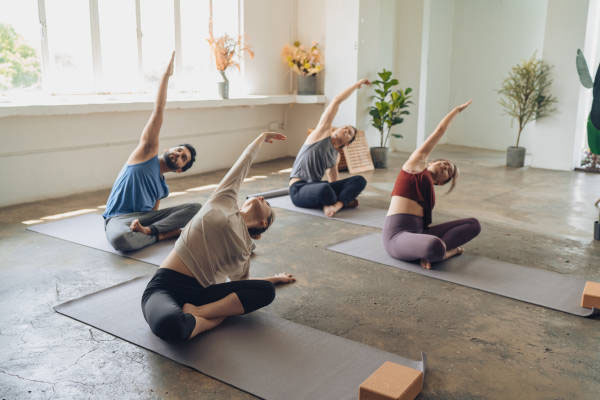Dive into the world of yoga as we explore the fundamental actions that define this ancient practice Discover the essence of yoga and how it harmonizes body, mind, and spirit Whether you re new to yoga or a seasoned practitioner, this guide will illuminate the path to well-being and self-discovery
Yoga, often regarded as a holistic practice for physical, mental, and spiritual well-being, is a journey that transcends the boundaries of exercise. At its core, yoga is about understanding and nurturing the harmony between the body, mind, and spirit. This exploration begins with the fundamental question, "What are the basic actions of yoga?"
For those stepping onto the path of yoga, understanding these fundamental actions is akin to learning the alphabet before reading a book. It's the foundation upon which the entire practice is built. Whether you're new to yoga or a seasoned practitioner, delving into the basic actions of yoga is a constant process of self-discovery and self-improvement.
In this article, we will embark on a journey to uncover the essential actions that define yoga. We will explore how yoga postures (asanas), breath control (pranayama), meditation, and mindfulness collectively contribute to a harmonious life. So, let's begin by unraveling the essence of yoga and its basic actions.

Understanding Yoga
Yoga is a profound and ancient practice that has its roots in India. It goes far beyond physical postures and exercise; it's a holistic approach to achieving balance and harmony in the mind, body, and spirit. The word "yoga" itself means to unite or join, signifying the union of various aspects of our being. In this section, we will delve into the core concepts that define the practice of yoga and explore its enduring significance in our fast-paced modern world.
At its heart, yoga seeks to bring about a union between the individual consciousness and the universal consciousness. It's a path of self-discovery and self-realization. While many often associate yoga with physical postures or asanas, it encompasses a diverse range of practices that include meditation, pranayama (breath control), ethical guidelines for living, and deep philosophical insights.
Yoga offers a holistic approach to health, well-being, and personal growth. It's not confined to any particular religion or belief system, making it accessible to people from all walks of life. Its benefits extend beyond the physical realm, promoting mental clarity, emotional balance, and a sense of inner peace.
Today, in a world filled with constant busyness and stress, yoga provides a refuge. It offers a way to reconnect with oneself, alleviate the strains of modern life, and find a sense of calm within. By understanding the essence of yoga, you can embark on a journey of self-discovery, inner peace, and enhanced physical and mental well-being.
Basic Asanas (Postures)
Basic asanas, or yoga postures, are the cornerstone of any yoga practice. They are physical poses designed to enhance strength, flexibility, balance, and overall physical well-being. These postures are more than just exercises; they are pathways to improved health and a harmonious connection between the body and mind.
Among the fundamental asanas are poses like the Mountain Pose (Tadasana), Downward-Facing Dog (Adho Mukha Svanasana), and the Child's Pose (Balasana). These poses serve as the building blocks for more advanced postures and provide a strong foundation for your yoga journey.
What makes basic asanas so powerful is their accessibility. They can be tailored to suit practitioners of all levels, from beginners to experienced yogis. Each asana has specific benefits, from the gentle stretch of the Seated Forward Bend (Paschimottanasana) to the core-strengthening Boat Pose (Navasana).
These postures not only foster physical strength and flexibility but also help calm the mind. Yoga practitioners often find that while focusing on the alignment of their bodies, they achieve mental clarity and a sense of peace. The rhythmic flow of breath during asana practice aids in mindfulness, bringing a meditative quality to each movement.
Basic asanas are not just about the physical form; they are about learning to listen to your body, finding your edges, and honoring your own unique capabilities. As you progress in your yoga journey, these foundational poses will continue to be your trusted companions, guiding you toward deeper self-awareness and a more balanced, harmonious life.
Pranayama (Breath Control)
Pranayama, the practice of breath control in yoga, plays a vital role in achieving physical and mental balance. The word "prana" means life force, and "yama" means control. Together, pranayama encompasses a range of techniques designed to regulate and harness the breath for overall well-being.
The breath is a bridge between the body and the mind, and pranayama is the art of using that bridge to calm the fluctuations of the mind. By consciously controlling the breath, you can influence your mental and emotional states. Pranayama techniques include deep breathing, alternate nostril breathing, and breath retention, among others.
One of the fundamental pranayama practices is the three-part breath, or "Dirga Pranayama." It involves inhaling deeply into the abdomen, expanding the ribcage, and finally filling the upper chest. This technique helps increase lung capacity and oxygenates the body, promoting relaxation and reducing stress.
Benefits of pranayama include improved lung function, reduced anxiety, and enhanced focus and concentration. By integrating pranayama into your yoga practice, you can experience a profound sense of inner peace and heightened self-awareness. The rhythmic nature of breath control fosters mindfulness, making it an essential aspect of holistic health.
Pranayama is a practice that is accessible to practitioners of all levels. Whether you are a beginner or an experienced yogi, the art of breath control can be a powerful tool in your journey toward a balanced, harmonious life. By mastering the breath, you can achieve a deeper connection between your body and mind, paving the way for greater well-being.
Meditation and Mindfulness
Meditation and mindfulness are integral components of yoga practice, offering a profound journey into self-awareness and inner peace. While yoga postures (asanas) work on the physical body, meditation and mindfulness delve into the realm of the mind and spirit, fostering mental clarity and emotional balance.
Meditation is a practice that encourages focused attention and concentration. It involves sitting in a quiet space, observing the breath, and allowing thoughts to come and go without judgment. This process cultivates a sense of calm and inner stillness. By meditating regularly, individuals often find increased emotional resilience and a reduced sense of anxiety or stress.
Mindfulness, on the other hand, is about being fully present in the moment, no matter what you are doing. Whether you're eating, walking, or simply sitting, mindfulness invites you to pay attention to the sensations, thoughts, and emotions that arise without attachment. It encourages a non-judgmental awareness of your experiences.
Both meditation and mindfulness bring about a heightened level of self-awareness. They enable you to connect more deeply with your inner self and understand your thought patterns and emotional responses. This enhanced self-awareness can lead to greater personal growth, emotional intelligence, and a sense of inner peace.
These practices are accessible to everyone and can be incorporated into your daily routine. Whether you have just started your yoga journey or have been practicing for years, meditation and mindfulness can be powerful tools for enhancing the quality of your life. By developing a clear and focused mind, you can navigate the challenges of the modern world with grace and equanimity.
Benefits of a Regular Yoga Practice
A consistent yoga practice offers a wide array of physical, mental, and emotional benefits that contribute to overall well-being. As you commit to regular sessions on the mat, you'll notice transformative changes in various aspects of your life.
Physically, yoga enhances flexibility, strength, and balance. The asanas (postures) help you stretch and tone your muscles, improving your posture and preventing injuries. Yoga is renowned for its ability to alleviate chronic pain, including back pain and arthritis.
Yoga is not just about physical exercise; it's also a practice of mindfulness and stress reduction. Regular yoga sessions reduce stress and anxiety, promote relaxation, and enhance mental clarity. The combination of physical movement and breath control creates a calm, meditative state of mind.
One of the remarkable benefits of yoga is its impact on cardiovascular health. It can lower blood pressure, improve heart rate variability, and reduce the risk of heart disease. The meditative aspects of yoga also enhance emotional health, helping individuals cope with depression and anxiety.
On an emotional and spiritual level, yoga cultivates self-awareness and self-acceptance. It fosters a deeper connection with your inner self and a greater understanding of your life's purpose. Many find that yoga contributes to a sense of inner peace and harmony with the universe.
As you embrace a regular yoga practice, you'll experience a holistic transformation. Your physical health will improve, your mind will find solace, and your spirit will flourish. It's a journey of self-discovery and well-being that extends far beyond the mat and into the fabric of your daily life.
FAQs: Benefits of a Regular Yoga Practice
Q1: What are the physical benefits of a regular yoga practice?
A1: A regular yoga practice enhances physical flexibility, strength, balance, and posture. It helps in muscle toning, prevents injuries, and can alleviate chronic pain, such as back pain and arthritis.
Q2: How does yoga contribute to stress reduction and mental clarity?
A2: Yoga combines physical movement with breath control, creating a meditative state of mind. This results in stress reduction, reduced anxiety, and enhanced mental clarity, providing a sense of relaxation and calm.
Q3: Can yoga positively impact cardiovascular health?
A3: Yes, yoga can lower blood pressure, improve heart rate variability, and reduce the risk of heart disease. Its meditative aspects also contribute to emotional well-being, helping individuals cope with conditions like depression and anxiety.
Q4: Does yoga offer emotional and spiritual benefits?
A4: Absolutely. Yoga fosters self-awareness and self-acceptance, deepening your connection with your inner self and life's purpose. Many practitioners find that it brings a sense of inner peace and harmony.
Q5: How does yoga extend beyond the physical practice?
A5: Yoga is a holistic journey that extends beyond the mat and into daily life. It transforms not only your physical health but also your mental and emotional well-being, offering a pathway to self-discovery and overall wellness.










